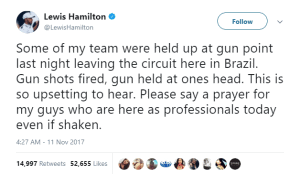
What does Travel Risk Management mean for you?
“A safe fairyland is untrue to all worlds.” J.R.R. Tolkien
The quote above is as true now as it was then; some would argue even more so. Its author arguably knew a thing or two about the ‘hero’s journey’, the monomyth ubiquitous amongst all cultures, an archetypal tale of a hero’s call to adventure, their victory in overcoming arduous trials and subsequent triumphant return. Whatever our business or profession, we all want to be that hero: we want to cast ourselves, our projects and beliefs out into world and, most importantly, return wiser and richer. It appears that one such group of heroes, Formula 1 superstar Lewis Hamilton and his team, put Tolkien’s theory to the test. One of the more disconcerting social media posts from this year was the result:

Happily, the stoic team went on to win the day, but this was the tip of the iceberg. During the Brazilian Grand Prix, Mercedes, Williams, Pirelli, Sauber and IFA personnel diced with danger. What is clear is that the organisations and their personnel involved in the Brazilian Grand Prix suffered bad press and financial losses and narrowly escaped catastrophic results. This is just one example out of countless instances across the globe, but it forms the basis of a good case study from which all organisations can learn in terms of creating a Travel Risk Management Programme (TRMP).
Firstly, we must consider what is at the heart of such a programme: ‘Duty of Care’. An organisation holds moral, and often legal, obligations to protect employees from dangers and hazards that are intrinsic to travel. Odysseus needs his Athena, Frodo needs his Gandalf, and employees need a management team to guide and give assistance whilst they represent a company. Unlike the aforementioned demi-gods, no one can be expected to see the future, but all foreseeable eventualities must be considered. Would it have been possible to determine that certain intersections in the vicinity of high-crime favelas would be crossed by F1 paddock teams travelling back to their hotel? With some rudimentary desk research, one can see that the answer is yes.
With ‘Duty of Care’ in mind, an organisation can start to build, or indeed re-build its TRMP. Those in direct charge of TRM such as travel managers and security directors must be gathered along with other stakeholders from HR, legal, health and safety or any other relevant department. Their expertise and input should be put to good use to identify all issues potentially arising from business travel. From this point on, an ongoing culture of care, safety and security should be embedded in travel policy.
Good policies cover everyone’s needs, considering perspectives of experience, previous training, health, gender and race as each individual’s profile will present different challenges in different locales and eventualities. An older traveller with a history of medical conditions may have to work within a certain radius of a fully functional hospital. A sports star might require an accompanying security detail and/or armoured vehicle; however, this does not mean less high-profile personnel should be neglected.
The stakeholders will have to be assigned appropriate roles in routine and emergency travel situations. Who authorises travel in the first place? Who is responsible for maintaining records on the employees that are travelling? Who contacts their next of kin? Has all the company’s travel been booked from one central point or Travel Management Company? If the travel arrangements are exceedingly complex or cover an area known to be dangerous it may be sensible to contact the various internal stakeholders to understand the risks and maybe a specialist travel management company for further support. Understanding the limitations of your organisation, travellers, the places you operate is a great place to start; not forgetting the limitations of your emergency plans.
A robust travel risk management company will be able to advise on travel policy and bring considerable savings in terms of efficiency, especially considering that their bread and butter will consist of the production of up to the minute regional intelligence reports and Travel Risk Assessments. They should invest time in understanding their client and their business in order to create bespoke plans tailored to the profile of an organisation and its travellers, meaning they will understand the exact level of support needed to ensure successful travel. Also, in facilitating this they will be able to provide anything from chaperones and translators to trained and vetted drivers and if required in-country security support. Even something as simple as an airport meet and greet can set the tone for a business excursion and get it off on the right foot.
Communication and information are key part of travel safety, not just to avoid danger but to give peace of mind to all parties. Traveller tracking platforms such as Priavo’s ‘locate’ can help monitor employees and provide them with up-to-date country information and advice. Should an emergency arise the system can be activated and the control centre along with emergency contacts will be immediately contacted; allowing them to pin-point employees anywhere. The platform also allows organisations to contact their whole mobile workforce instantly though its mass notification tool.
For a relatively small investment in time and effort, organisations can create robust Travel Management Programmes that have fantastic benefits. Employees can go about their tasks confidently, unfettered by the emotional stress of unsafe travel and galvanised by the knowledge that they are genuinely looked after by a communicative and efficient management structure. Most of all, the spirit of enterprise and adventure can stay alive, risk can be turned into reward as the business is not paralysed with undue fears, and an organisation’s heroes can complete their journey.
